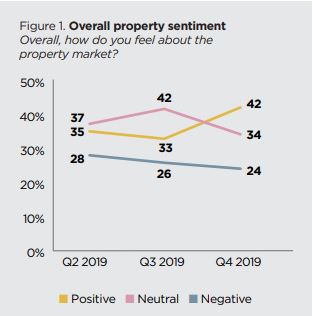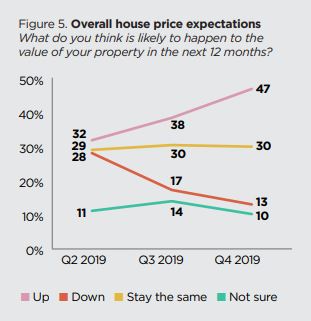Property sentiment growing as house prices predicted to keep rising
Contact
Property sentiment growing as house prices predicted to keep rising
Australians are feeling positive towards the current real estate market, according to findings from ME's third Quarterly Property Sentiment Report.
Property market sentiment has rebounded, with a greater percentage of Australians reporting they are feeling positive towards the current market.
That was the standout finding from ME’s third Quarterly Property Sentiment Report, conducted in October 2019.
The report shows sentiment towards the property market has improved considerably over the past quarter, with 42 per cent of Australians in the property market feeling positive about the market (up 9 percentage points) and 24 per cent feeling negative (down 2 percentage points).
At a glance:
- Property market sentiment has improved 42 per cent.
- Positive sentiment has grown across every age group.
- Standout states were NSW, VIC and QLD, where 57 per cent are predicting prices to go up
Sentiment also improved across the board for every age group, property status and property intention.
Millennials, investors and those who plan to buy in the next 12 months stood out as the most optimistic within their respective cohorts.
ME’s General Manager Home Loans, Andrew Bartolo said the past three months have been a critical time for the property market.
“After a period of price declines in Australia’s key property markets, consistent house price increases over the past three months have created a much-needed period of stability, providing more certainty that early price increases weren’t simply a blip in the data," said Mr Bartolo.
“However, sentiment among first home buyers didn’t surge as much as others, which suggests the recent house price movements may have marked the end of a unique opportunity to buy ‘at the bottom’.
"The recent uptick in first home buyer activity recorded by the ABS may represent the scramble to get in while they can due to renewed affordability pressures as prices rise.”
Almost half predict house prices will keep rising.
Expectations for house prices over the next 12 months have soared, with now almost half of Australians in the property market (47 per cent) expecting prices to rise (vs. 32 per cent in April, 38 per cent in July), only 13 per cent expecting prices to fall (vs. 28 per cent in April, 17 per cent in July), and 30 per cent expecting them to stay the same.
Respondents across all major cities had a more positive outlook on prices, except for WA where price rises were predicted less likely than three months ago.
The standout states were NSW, VIC and QLD, where 57 per cent are predicting prices to go up, jumping up by as much as 25 percentage points from last quarter’s predictions.
Positive house price expectations were also seen across all property status types.
“The surge in optimism about houses prices over the past six months reflects just how much the external environment has changed since ME launched its first Quarterly Property Sentiment Report in April,” said Mr Bartolo.
“With a relatively solid spring selling season and a number of months’ worth of house value growth under the belt - according to CoreLogic data - there’s more confidence that the upward rajectory of prices will continue, albeit modest increases.”
The report found more Australians are willing to get back into the property market after a period of sitting on the fence; more are intending to buy (up 2 percentage points), more are intending to sell (up 4 percentage points) and less are intending to do neither (down 4 percentage points).
Millennials are in fact the most likely to be transacting in property, with their likelihood to buy or sell having increased by 8 percentage points in the last quarter.
When looking at property intentions by income, the most likely buyers are now those earning $100,000 to $125,000 a year (45 per cent), taking the top spot from those earning over $125,000 (36 per cent).
In terms of property intentions by property status, investors remain the most likely to be transacting in the property market, however their interest did dip slightly (5 percentage points) from last quarter; overall 66 per cent of investors, 48 per cent of first home buyers and 45 per cent of owner occupiers intend to buy and/or sell in the next 12 months.
“Over the past six months we’ve noticed people taking a ‘wait and see’ approach to the market," said Mr Bartolo.
"While the increase in plans to transact in the market is modest, greater positive sentiment in the market suggests the recent interest rate changes, house prices, auction clearance rates etc. are making an impact."
The report also tracked the perception of supply in the property market for the first time and found half of total respondents believe there is currently enough choice in the property market, however only a third of first home buyers believe this to be the case as they struggle to get their foot in the door.
Northern Territory residents overwhelmingly think (75 per cent) there’s not enough choice, while WA thinks they’re the most spoilt for choice when it comes to the houses on offer in their area.
“Housing supply is lower than last spring and the competition can be felt among those currently buying, so it’s not surprising that only 1 in 2 Aussies think there’s enough choice available,” said Mr Bartolo.
Price movements have had a largely positive impact on many aspects of people’s financial situation.
Recent property price movements shifted ‘sense of wealth’ from net negative 4 per cent in July to net positive 10 per cent.
Likewise, ‘financial confidence’ has improved from net negative 5 per cent in July to net positive 6 per cent.
Savings behaviour has remained relatively strong, however there’s a bit more willingness to spend on discretionary items, which Mr Bartolo said is encouraging to see.
Debt situation has also improved from net positive 4 per cent to net positive 9 per cent.
Similar to this:
'Sharp' drop in property sentiment amid concerns for economic growth
Structural changes emerge as more first home buyers enter the market: report
Why clearance rates are a sign of seller – not buyer – sentiment







